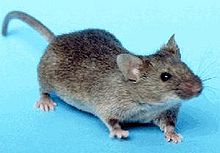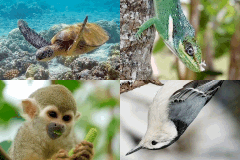 AnAge entry for Mus musculus
AnAge entry for Mus musculus
Classification (HAGRID: 02697)
- Taxonomy
-
Kingdom: Animalia
Phylum: Chordata
Class: Mammalia (Taxon entry)
Order: Rodentia
Family: Muridae
Genus: Mus
- Species
- Mus musculus
- Common name
- House mouse
- Synonyms
- Mus molossinus, Mus nordmanni, Mus musculus cinereomaculatus, Mus bactrianus tantillus, Mus musculus varius, Mus molossinus yonakuni
Lifespan, ageing, and relevant traits
- IMR
- 0.01/year
- MRDT
- 0.3 years
- Maximum longevity
- 4 years (captivity)
- Source
- ref. 506
- Sample size
- Large
- Data quality
- High
- Observations
A major model of biomedical research, mice are amongst the fastest ageing mammals exhibiting a variety of physiological, functional and pathological changes with age. The record longevity for normal mice is 4 years, belonging to one male specimen from a wild-derived strain kept in the lab [0506]. Mutant and caloric restricted mice, however, can live over 4 years [0011], though these are not deemed suitable for species comparisons; amongst these, record longevity belongs to a mutant dwarf mouse that lived 1819 days (Andrzej Bartke, pers. comm.). Smaller mice tend to live longer [0567].
Cancer is usually the major cause of death in mice, although there is considerable variation between strains and the most common type of cancer varies between strains. Even long-lived wild-derived animals, however, die primarily of cancer [0738]. Various degenerative conditions, including in the heart and kidneys as well as cognitive ageing, have been observed in mice [0981]. Dozens of genes have been identified in mice that extend lifespan.
Life history traits (averages)
- No information is available on life history. Please contact us if you wish to suggest or contribute data.
Metabolism
- Typical body temperature
- 310ºK or 36.9ºC or 98.4ºF
- Basal metabolic rate
- 0.2710 W
- Body mass
- 18.0 g
- Metabolic rate per body mass
- 0.015056 W/g
Species in other databases
References
- [1242] Marck et al. (2017), Age-Related Changes in Locomotor Performance Reveal a Similar Pattern for Caenorhabditis elegans, Mus domesticus, Canis familiaris, Equus caballus, and Homo sapiens (PubMed)
- [0966] Edrey et al. (2012), Sustained high levels of neuregulin-1 in the longest-lived rodents; a key determinant of rodent longevity (PubMed)
- [1103] Lazic (2012), Modeling hippocampal neurogenesis across the lifespan in seven species (PubMed)
- [0926] Yu et al. (2011), RNA sequencing reveals differential expression of mitochondrial and oxidation reduction genes in the long-lived naked mole-rat when compared to mice (PubMed)
- [1136] Gomes et al. (2011), Comparative biology of mammalian telomeres: hypotheses on ancestral states and the roles of telomeres in longevity determination (PubMed)
- [0981] Wolf and Austad (2010), Introduction: Lifespans and Pathologies Present at Death in Laboratory Animals
- [0912] Brown et al. (2009), Examining the mechanisms responsible for lower ROS release rates in liver mitochondria from the long-lived house sparrow (Passer domesticus) and big brown bat (Eptesicus fuscus) compared to the short-lived mouse (Mus musculus) (PubMed)
- [0917] Ungvari et al. (2008), Testing hypotheses of aging in long-lived mice of the genus Peromyscus: association between longevity and mitochondrial stress resistance, ROS detoxification pathways, and DNA repair efficiency (PubMed)
- [0776] Seluanov et al. (2007), Telomerase activity coevolves with body mass not lifespan (PubMed)
- [0777] Harper et al. (2007), Skin-derived fibroblasts from long-lived species are resistant to some, but not all, lethal stresses and to the mitochondrial inhibitor rotenone (PubMed)
- [0786] Andziak and Buffenstein (2006), Disparate patterns of age-related changes in lipid peroxidation in long-lived naked mole-rats and shorter-lived mice (PubMed)
- [0754] Labinskyy et al. (2006), Comparison of endothelial function, O2-* and H2O2 production, and vascular oxidative stress resistance between the longest-living rodent, the naked mole rat, and mice (PubMed)
- [0738] Harper et al. (2006), Does caloric restriction extend life in wild mice? (PubMed)
- [0607] Dou et al. (2006), Co-evolutionary analysis of insulin/insulin like growth factor 1 signal pathway in vertebrate species (PubMed)
- [0742] Miller and Austad (2006), Growth and aging: why do big dogs die young?
- [0603] Andziak et al. (2005), Antioxidants do not explain the disparate longevity between mice and the longest-living rodent, the naked mole-rat (PubMed)
- [0715] Lorenzini et al. (2005), Cellular replicative capacity correlates primarily with species body mass not longevity (PubMed)
- [0011] Bartke and Brown-Borg (2004), Life extension in the dwarf mouse (PubMed)
- [0429] Quarrie and Riabowol (2004), Murine models of life span extension (PubMed)
- [0331] Fukumoto et al. (2004), Beta-secretase activity increases with aging in human, monkey, and mouse brain (PubMed)
- [0036] Savage et al. (2004), The predominance of quarter-power scaling in biology
- [0051] Liang et al. (2003), Genetic mouse models of extended lifespan (PubMed)
- [0610] Ernest (2003), Life history characteristics of placental non-volant mammals
- [0567] Miller et al. (2002), Big mice die young: early life body weight predicts longevity in genetically heterogeneous mice (PubMed)
- [0506] Miller et al. (2002), Longer life spans and delayed maturation in wild-derived mice (PubMed)
- [0217] Ogburn et al. (2001), Exceptional cellular resistance to oxidative damage in long-lived birds requires active gene expression (PubMed)
- [0053] Guarente and Kenyon (2000), Genetic pathways that regulate ageing in model organisms (PubMed)
- [0069] Gershon and Gershon (2000), Paradigms in aging research: a critical review and assessment (PubMed)
- [0857] Turturro et al. (1999), Growth curves and survival characteristics of the animals used in the Biomarkers of Aging Program (PubMed)
- [0434] Ronald Nowak (1999), Walker's Mammals of the World
- [0403] Herrero and Barja (1998), H2O2 production of heart mitochondria and aging rate are slower in canaries and parakeets than in mice: sites of free radical generation and mechanisms involved (PubMed)
- [0441] William Burt et al. (1998), A Field Guide to Mammals
- [0405] Holmes and Austad (1995), Birds as animal models for the comparative biology of aging: a prospectus (PubMed)
- [0404] Barja et al. (1994), Low mitochondrial free radical production per unit O2 consumption can explain the simultaneous presence of high longevity and high aerobic metabolic rate in birds (PubMed)
- [0014] Leonard Hayflick (1994), How and Why We Age
- [0305] Sohal et al. (1993), Biochemical correlates of longevity in two closely related rodent species (PubMed)
- [0455] Virginia Hayssen et al. (1993), Asdell's Patterns of Mammalian Reproduction: A Compendium of Species-Specific Data
- [0002] Caleb Finch (1990), Longevity, Senescence, and the Genome
- [0272] Anderson and King (1988), Subclinical lumbar polyradiculopathy in multiple aged mammalian species (PubMed)
- [0326] Wilson et al. (1987), Genomic 5-methyldeoxycytidine decreases with age (PubMed)
- [0680] Wootton (1987), The effects of body mass, phylogeny, habitat, and trophic level on mammalian age at first reproduction
- [0309] Torello et al. (1986), A comparative-evolutionary study of lipids in the aging brain of mice (PubMed)
- [0478] Baudry et al. (1986), Low levels of calpain activity in Chiroptera brain: implications for mechanisms of aging (PubMed)
- [0110] Lippman (1985), Rapid in vivo quantification and comparison of hydroperoxides and oxidized collagen in aging mice, rabbits and man (PubMed)
- [0325] Passingham (1985), Rates of brain development in mammals including man (PubMed)
- [0310] Cutler (1984), Urate and ascorbate: their possible roles as antioxidants in determining longevity of mammalian species (PubMed)
- [0311] Su et al. (1984), Longevity-dependent organ-specific accumulation of DNA damage in two closely related murine species (PubMed)
- [0731] Zullinger et al. (1984), Fitting sigmoid equations to mammalian growth curves
- [0312] Martin et al. (1983), Comparative rates of decline in the primary cloning efficiencies of smooth muscle cells from the aging thoracic aorta of two murine species of contrasting maximum life span potentials (PubMed)
- [0248] Hulbert and Else (1981), Comparison of the "mammal machine" and the "reptile machine": energy use and thyroid activity (PubMed)
- [0606] Fry et al. (1981), On the activity and fidelity of chromatin-associated hepatic DNA polymerase-beta in aging murine species of different life spans (PubMed)
- [0059] Tolmasoff et al. (1980), Superoxide dismutase: correlation with life-span and specific metabolic rate in primate species (PubMed)
- [0436] Cutler (1979), Evolution of human longevity: a critical overview (PubMed)
- [0315] Hart et al. (1979), Longevity, stability and DNA repair (PubMed)
- [0013] Alex Comfort (1979), Ageing: The Biology of Senescence
- [0534] Sacher and Hart (1978), Longevity, aging and comparative cellular and molecular biology of the house mouse, Mus musculus, and the white-footed mouse, Peromyscus leucopus (PubMed)
- [0953] Mouse Phenome Database
- [0975] Digital Ageing Atlas
External Resources
- Integrated Taxonomic Information System
- ITIS 180366
- Animal Diversity Web
- ADW account
- Encyclopaedia of Life
- Search EOL
- NCBI Taxonomy
- Taxonomy ID 10090
- Entrez
- Search all databases
- Ageing Literature
- Search Google Scholar or Search PubMed
- Images
- Google Image search
- Internet
- Search Google

